The story of my ongoing struggle to develop a piece of exposed Derbyshire hillside into a productive and beautiful garden.
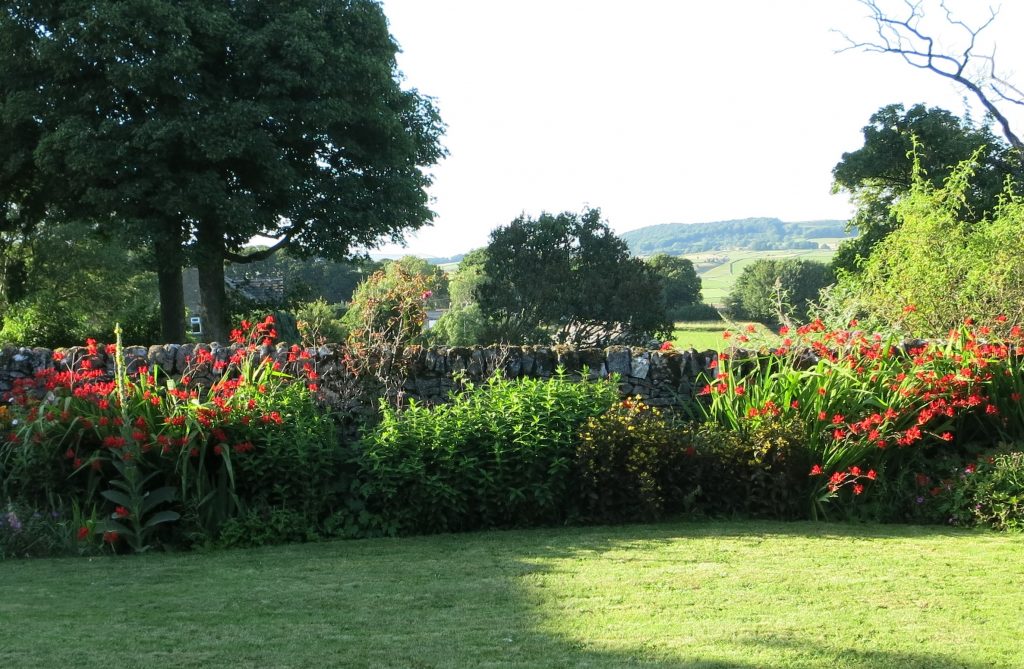
I moved to Derbyshire in 1981 and have spent the intervening years developing my plot, the ground consisting largely of a layer of unpromisingly thin clay soil over limestone rock. The house, which had been built in 1776 as two tiny semi-detached farm-workers cottages, but much altered through the centuries, had a long strip of front garden facing onto the road; a very small and roughly triangular piece of steeply sloping bank, dominated by a very large and ancient Sycamore, formed what could barely be termed a back garden. Despite the overwhelming challenges the Sycamore cast over the back garden as a space to grow anything very lovely, it was greatly enjoyed by our growing children as the perfect support for a swing, for climbing and for a tree house. To this day there remain, spiraling up the Sycamore’s trunk, several metal footholds gleaned from a telegraph pole that was felled, one icy winter’s evening, by a young man driving slightly too fast for the road conditions. They made a perfect “ladder” to aid ascent to the tree house. The tree has now almost consumed three of the metal footholds, but the rest remain usable.
The front garden was long and narrow, and divided into two distinct areas; the first, a plot in front of the original part of the house, which was further divided into two small gardens by a wide path from gate to front door, both put to lawns with flower beds aligning the path, and shrubs (Philadelphus, Kerria, Berberis, Holly and Cornus Silvestris) screening the garden from the road. There was a vast expanse of Cotoneaster Horizontalis clothing the remains of a wall which had, at one time, separated the garden from an adjoining field or croft, but which had been breached at the time the house was extended during the late 1960s, in order to give access to the other area of front garden; this was basically a long, narrow lawn bounded on the road side by shrubs (Lilac, Snowberry and Rose Spirea) and on the house side by a wide and steep rockery in the centre of which sat a large Weigela in a sea of variegated grass (and nettles). At the far end of the rockery was a large tree stump; the remains of what had obviously been an enormous and ancient tree and which, in the days before the invention of stump grinding machines, had simply been left to rot away naturally…. and incredibly slowly.
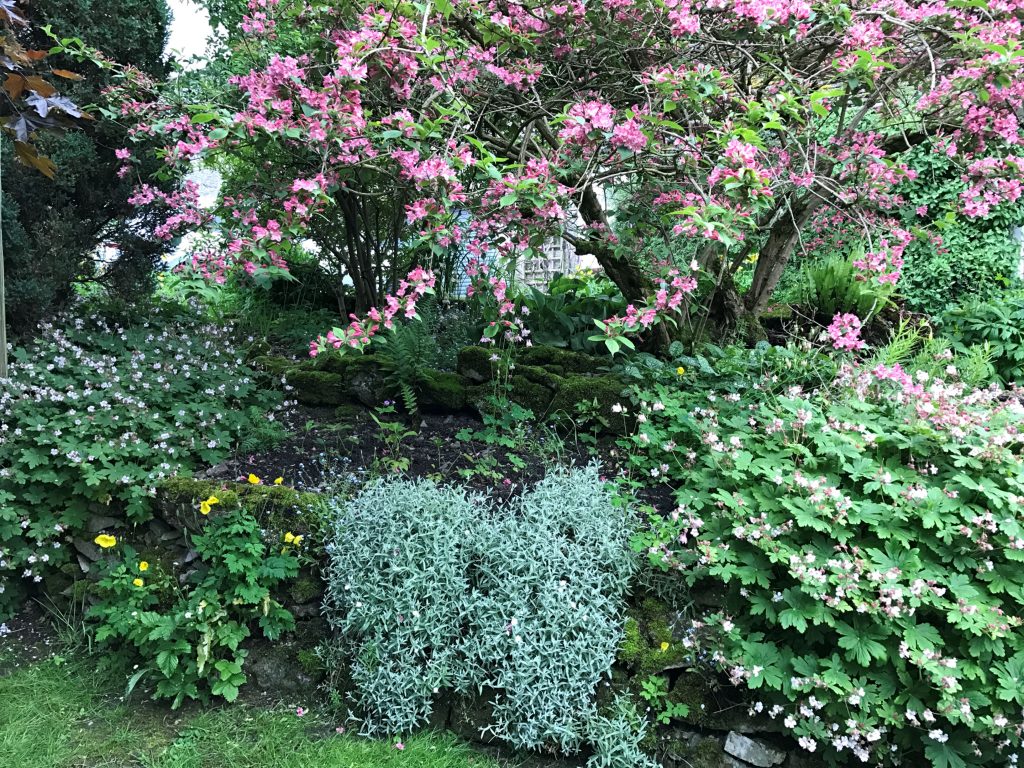
This being a “Hillside Garden” I should say something about the gradient; the roadside boundary is approximately 40 metres long, with a fall of about 4 metres from one end to the other, making an overall gradient of a mere 1 in 10 along the frontage.
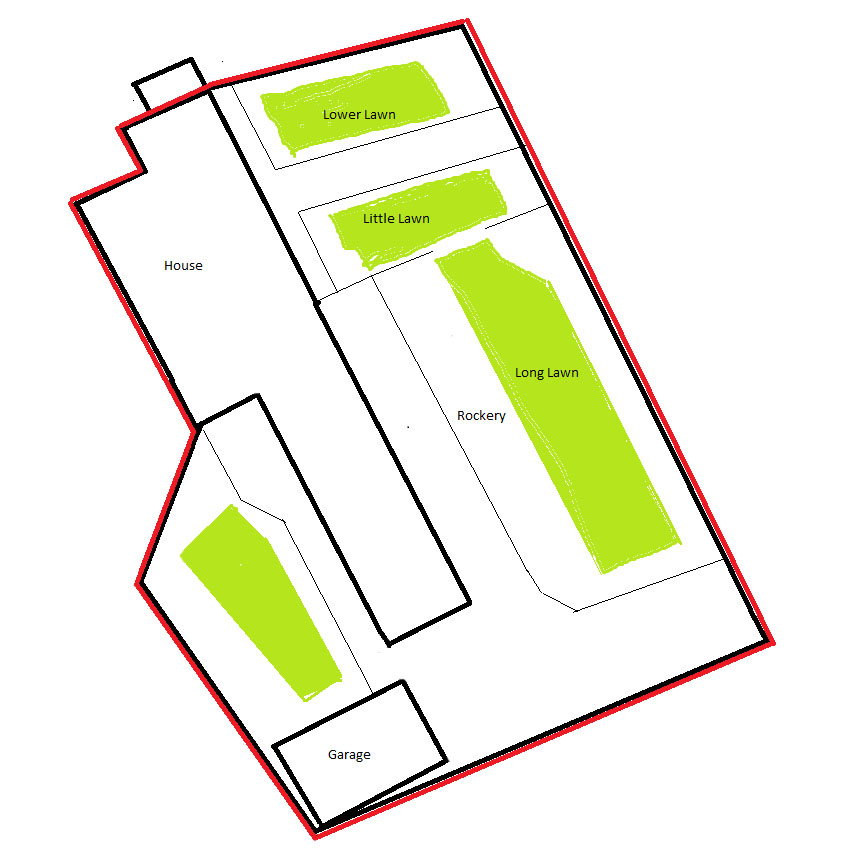
The original two cottages were built on bedrock, about a metre and a half higher than the roadside boundary, with the field, behind, sloping steeply upwards immediately behind the back wall of the house. The first floor of the house had been extended during the 1960s, the extension being a single storey built over solid rock and continuing the roofline to create a long building in keeping with many farmhouses in the area; as a result, the house appears to be upside down when you enter via the back door (on the first floor) but a perfectly normal two storey house when entered via the front door. Just how solid the bedrock is became clear in the early 1980s when we built a garage, which had to be sited about half a metre higher than intended because the bedrock was just too unyielding…. rock blasting with dynamite wasn’t really a feasible option. The rockery had been created in order to bridge the difference in height between the long lawn and the ground level of the extension.
The small back garden sloped upward a further couple of metres to the back boundary. Although the garden that I first took on was steeply inclined and set on various levels, and was sited on the lower slopes of a hillside, it didn’t really qualify for the term “Hillside Garden” until, many years later, we were able to obtain a sizeable chunk of the hillside….. more of which, later.
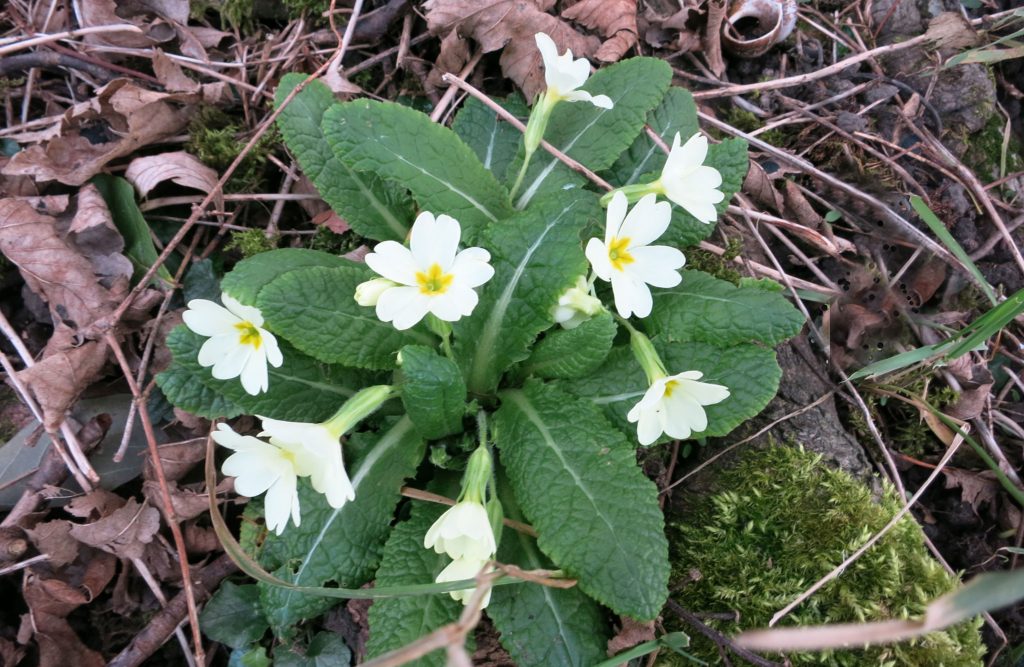
I remember the first things I planted in this garden, two of which still flourish to this day.
The first was a Primrose, an offshoot of a plant I had put in my elderly mother’s garden for sentimental reasons: I have vivid memories of being taken, during the Spring of the year in which I later turned four, to visit my mother’s family in her native Cornwall. At some point during this (presumably Easter) visit, I clearly remember sitting on a verdant wooded bank surrounded by a thick carpet of Primroses. When I think of it I can feel, in my finger ends, the squeaky sensation of gently pulling the pink and slightly furry stems, as we collected several bunches of this most beautiful of spring flowers. The stems of each bunch were carefully wrapped with wet cotton wool, then an outer wrapping of soggy newspaper tied with thread, and the bunches laid gently into a small, old-fashioned cardboard suitcase lined with newspaper, for their safe journey back to Yorkshire’s West Riding, where they were handed out to Grannies and Aunties. Primroses have had a very special place in my heart ever since.
The second plant was a Euphorbia Griffithii Fireglow given to me by a friend and fellow gardener. It has performed magnificently every year and chunks of it have been given to friends or moved to other spots as my garden has developed. I am particularly fond of this plant, not only for its aesthetic splendour, but because I, too, am a Griffithii.
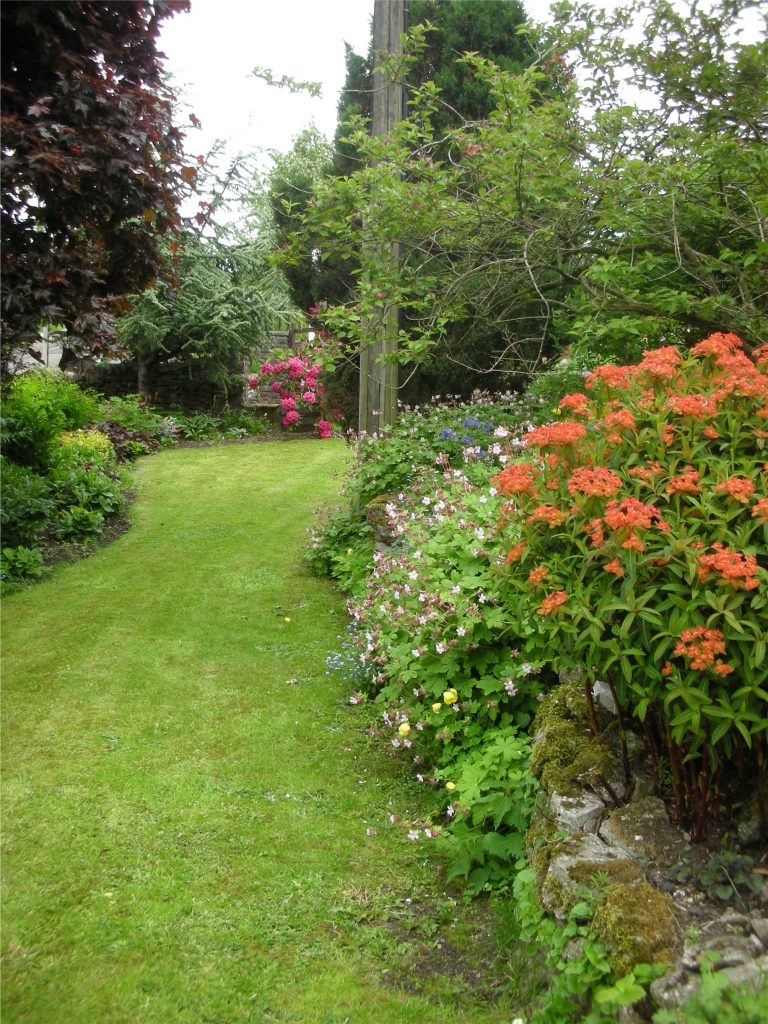
The third planting was a young twenty-inch high Fir tree sapling. In an effort to make something interesting out of the large, slowly rotting tree stump, I dug out what I could of the centre and filled it with soil and compost and got my six-year old stepson to plant the Fir tree, which I then surrounded with small Campanulas and hardy Geraniums. The stump gradually rotted away as the Fir tree grew, and the surrounding plants were largely squeezed out by the Fir’s increasing girth and the deep shade it created. It’s many years now since we had to fell the Fir tree; it had become threateningly tall and was casting far too much gloom over our house and that of our neighbours.
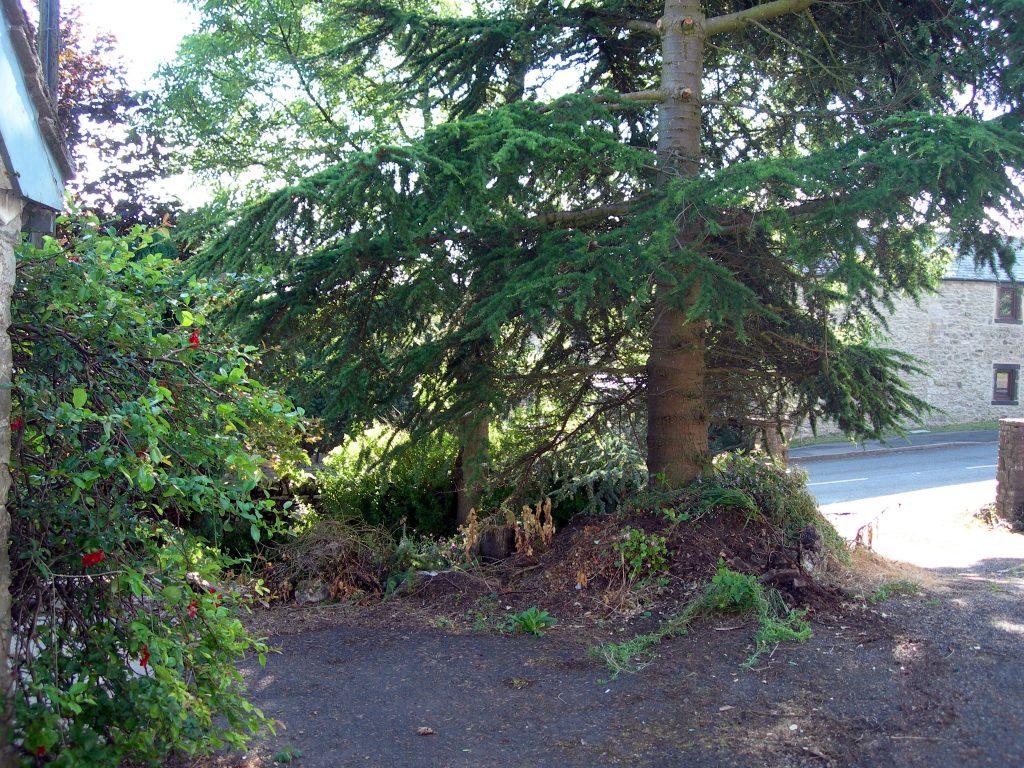
What I have failed to mention is the effort required before I was able to put in the three plants mentioned above. Although there was evidence that, at one time, the garden had been well stocked and cared for, the previous occupants were clearly not seasoned gardeners and, by the time I took the garden on, the mature shrubs were overgrown and what had been a rockery was choked with Twitch grass and head-high Nettles. The whole rockery had to be dismantled in order to tease out the tangled roots; some of the Nettle roots were so long that I actually laid them out and measured them: the longest being a few inches over 12 feet…. painstakingly picked out from under and around rocks and paths and the roots of the very large old Wiegela. The Rockery never really recovered as a rockery, although it is still referred to as such; it’s more of a raised and steeply sloping bank with a few rocks here and there retaining the soil. I planted it up with shade tolerant perennials including the afore mentioned Euphorbia Griffithii and Primroses, together with some exuberant hardy Geraniums, Persicaria, Ajuga, Iris Sibirica and Pulmonaria.
One particular issue is the presence of a telegraph pole that carries electricity cables diagonally across the property; although tempted to use it as a support for a Clematis, I decided that it would be better to draw the eye away from it rather than accentuating its presence, so I planted a young evergreen Cypress to give vertical structure. This tree has now reached such a size that we are going to have to face removing it before much longer; I shall then have to find another solution to the problem of the pole.
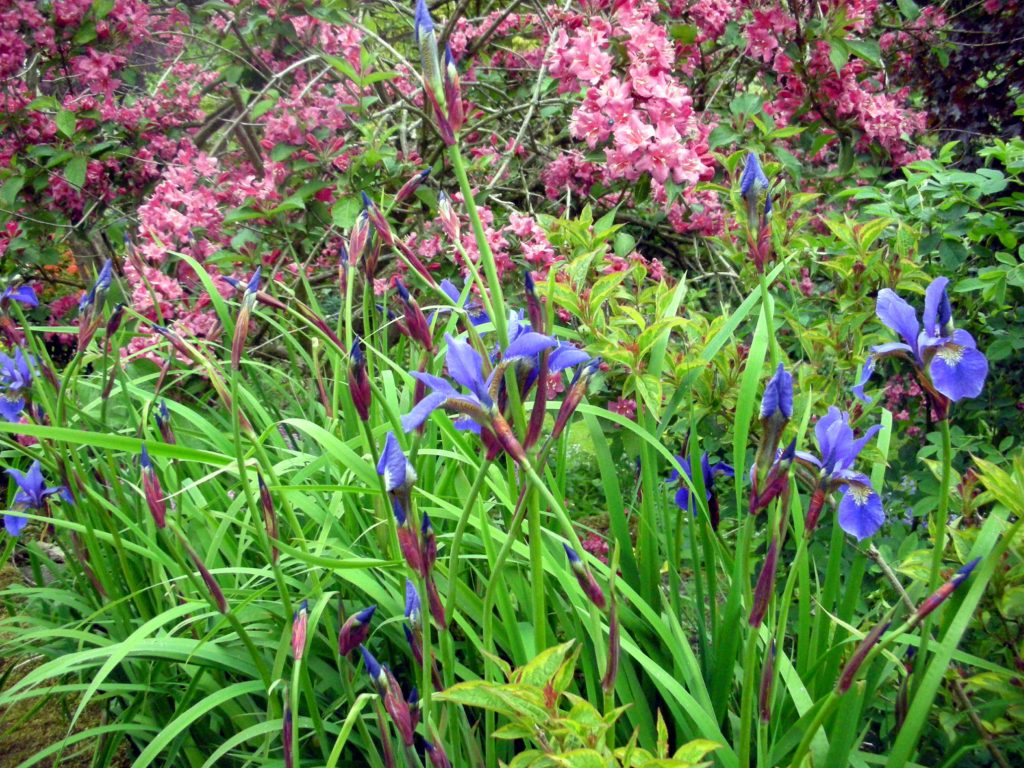
The next area to receive attention was the overgrown Cotoneaster Horizontalis. To replace the ugly, dated coal bunker that was taking up a sunny corner of what could otherwise be an extended flower bed, we wanted to create an underground coal bunker. The area beneath the Cotoneaster was little more than a mound of random chunks of limestone, readily suited to the excavation of a suitable bunker space. By removing the mound, the Cotoneaster and a large (and rather past its best) Spotted Laurel (Aucuba Japonica), we opened up the whole of the area, linking the long lawn with the lower garden to give a much more generous sense of space. As part of the redevelopment of this area, we demolished a set of steps which, although pleasing on the eye, having been constructed simply by the stacking of large slabs of rough limestone, were very uneven and quite dangerous to use as a main access route. The replacement steps, while a good deal safer, lack the charm of their predecessors and we intend, eventually, to replace them with something more aesthetically pleasing.
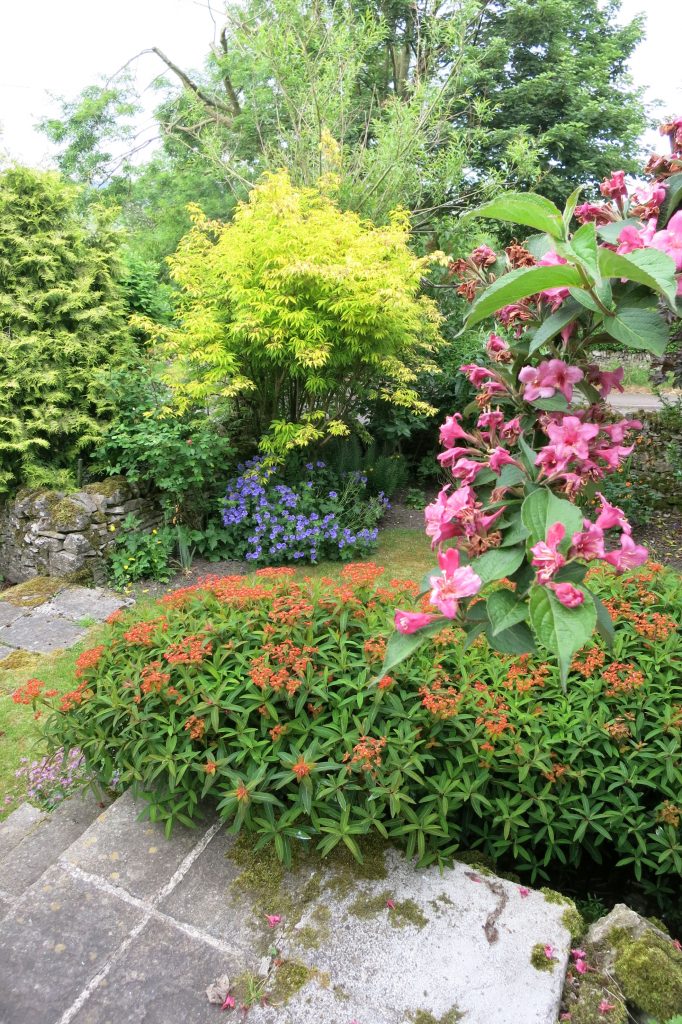
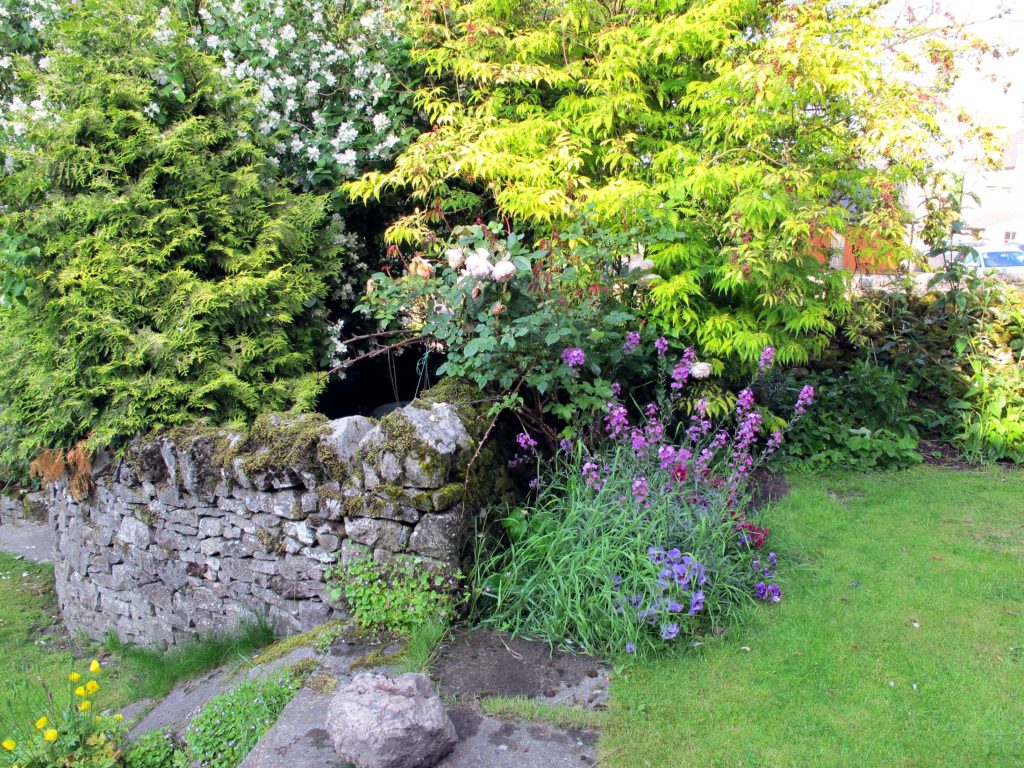
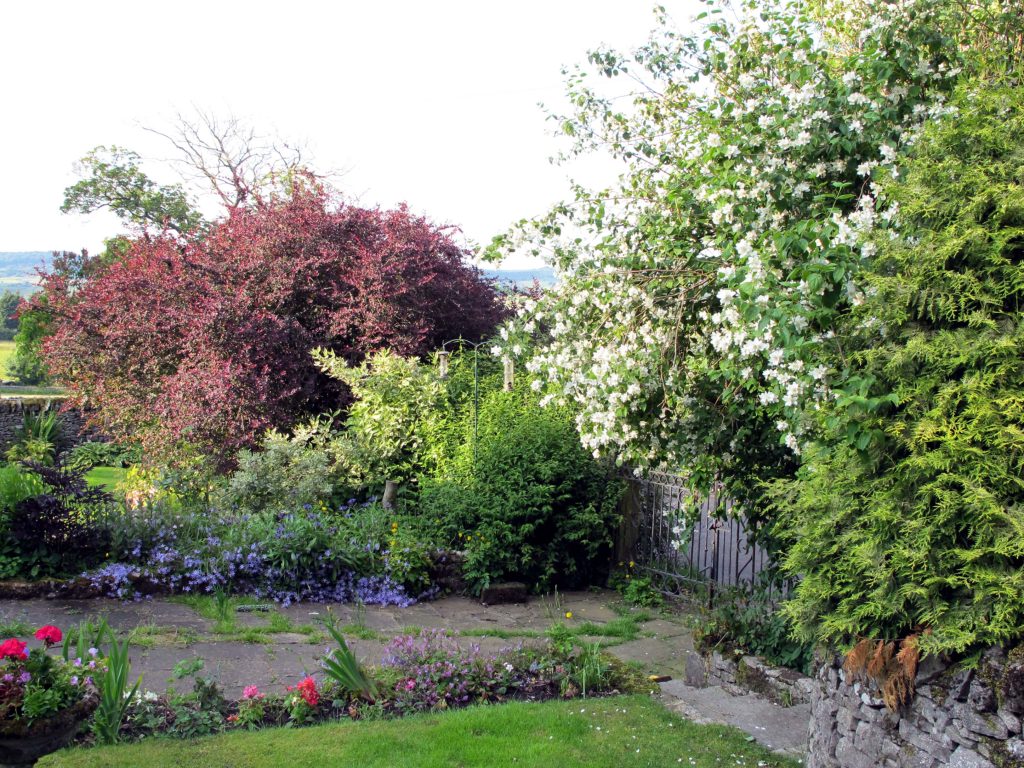
Attention was then turned to the garden immediately in front of the house; this was already divided into two halves by a wide, crazy-paved, double-gated path or driveway, running at a somewhat uncomfortable, almost diagonal angle from house to gate. By moving the gateway down by about a metre, we straightened up the drive considerably and, although still a long way from the perpendicular, it is much more comfortable on the eye. Moving a gateway sounds simple enough, but one must factor in the need to move a large, established Philadelphus (eight feet tall and six feet wide, with a massive root-ball) to the other side of the driveway, not to mention several other plants that had to be dug up and nursed until I had prepared new beds either side of the realigned drive, and a new lawn had to be laid within the extended area between the long lawn and the drive. This lawn is known as the “Little Lawn”, to differentiate it from its fellow front lawns, known as the “Long Lawn” and the “Lower Lawn”; but more of the Lower Lawn later…. let’s go back to the Long Lawn for now.
On demolishing the wall, removing the Cotoneaster and opening up the view to the long lawn, the overgrown shrubs along the road-side wall became much more of an issue; a purple Lilac had suckered over a wide area and was encroaching on the lawn and dislodging the dry-stone wall. A Snowberry filled about five yards of the bed, with a Rose Spirea filling the remainder and spreading through the wall into the grass verge beyond; the latter two shrubs were harbouring a network of tall Nettles.
Removal of the Lilac required many hours of back-breaking work with a mattock and crowbar; dig any reasonably sized hole in my garden and you’ll quickly hit rocks. Lilac roots had crept between, over and under dozens of lumps of limestone rock, each needing to be prised aside and out, before another section of root could be removed. It was during this work that I discovered that, at some point during the previous centuries, this part of the garden had been used as a midden; as well as the tons of rock, I retrieved all manner of pot shards, bones, dozens of pieces of clay pipe, a bent spoon and a somewhat twisted brass candle-snuffer.
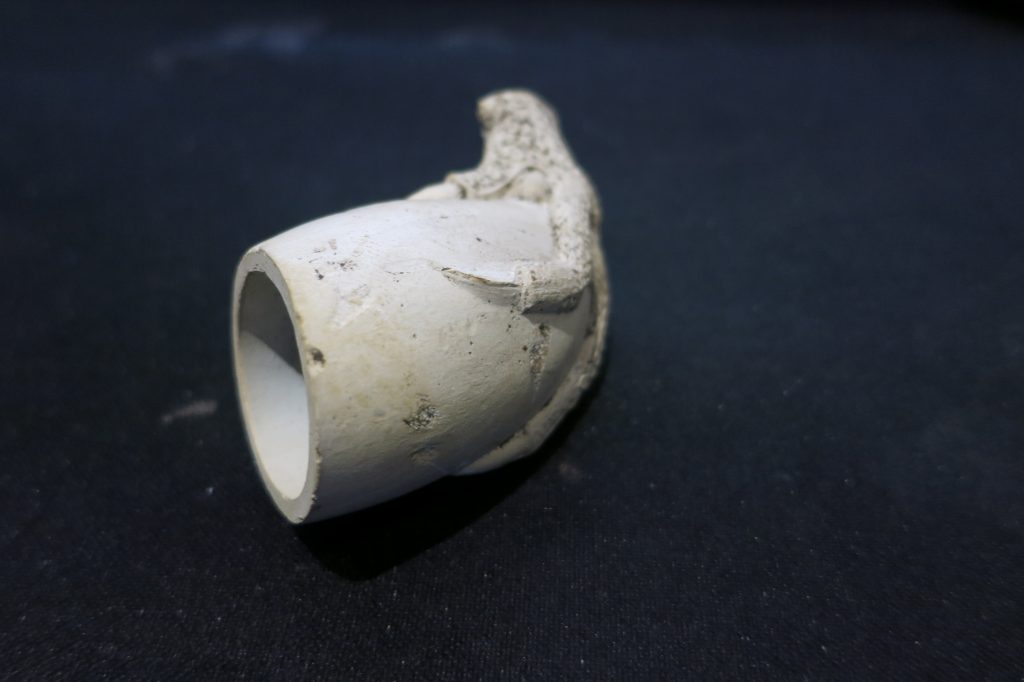
In exposing the dry-stone wall, it became apparent that it was not in a good state of repair and any attempt to remove shrub roots from within it would cause it to fall, so the decision was taken to rebuild the wall, digging out the roots in the process. I now had a blank canvas to work with and the first things I put in were the Norwegian Acer “Crimson King” in a fairly central and dominant position, and a Cedrus Atlantica Glauca in the furthest corner by the gatepost; next to this, alongside the top drive and positioned to disguise the drain cover beneath, I put a Rhododendron in a half barrel of ericaceous compost… a beautiful, lively pink but whose name was, sadly, not recorded. To replace the height that the Lilac had occupied, I planted a lime/yellow Sambucus…. so three very different trees in colour and habit.
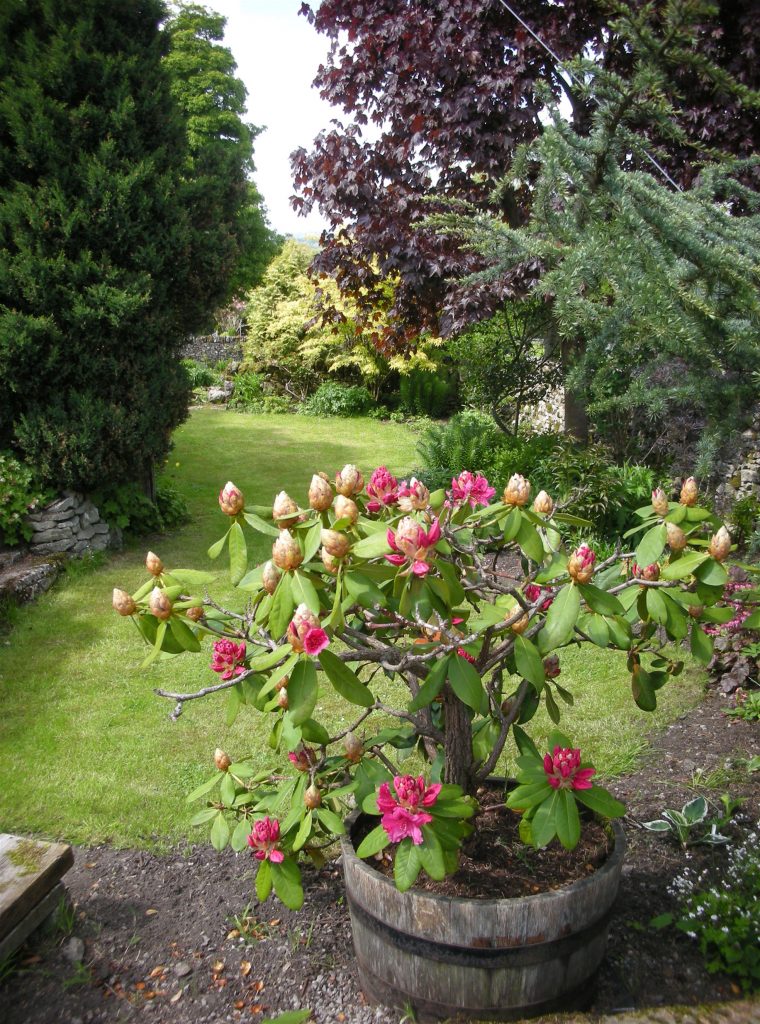
The bed spaces between the trees were planted with such perennials as Echinops, Leucanthemum, Yellow Loosetrife and Valerian, though a Holly, a Sambucus Nigra “Black Lace” and the climbing rose “William Morris” were added more recently and many more perennials have been trialed in this rather shady bed, some more successfully (Dicentra Spectabilis, Pulmonaria, Heuchera, Geum) than others (Paeony, Oriental Poppy, Verbascum, Echinacea). Despite the continued removal of rock and rubbish, and the addition of lots of compost and the occasional mulch, the soil here remains rather poor and the maturing trees cast shade. The overhanging branches of the Acer almost meet the huge and ancient Weigela on the opposite bank, creating a cool and inviting glade on a hot summer’s day… and on just such a day, the sunlight through the leaves of the Acer is utterly stunning… it truly justifies its name of “Crimson King”.
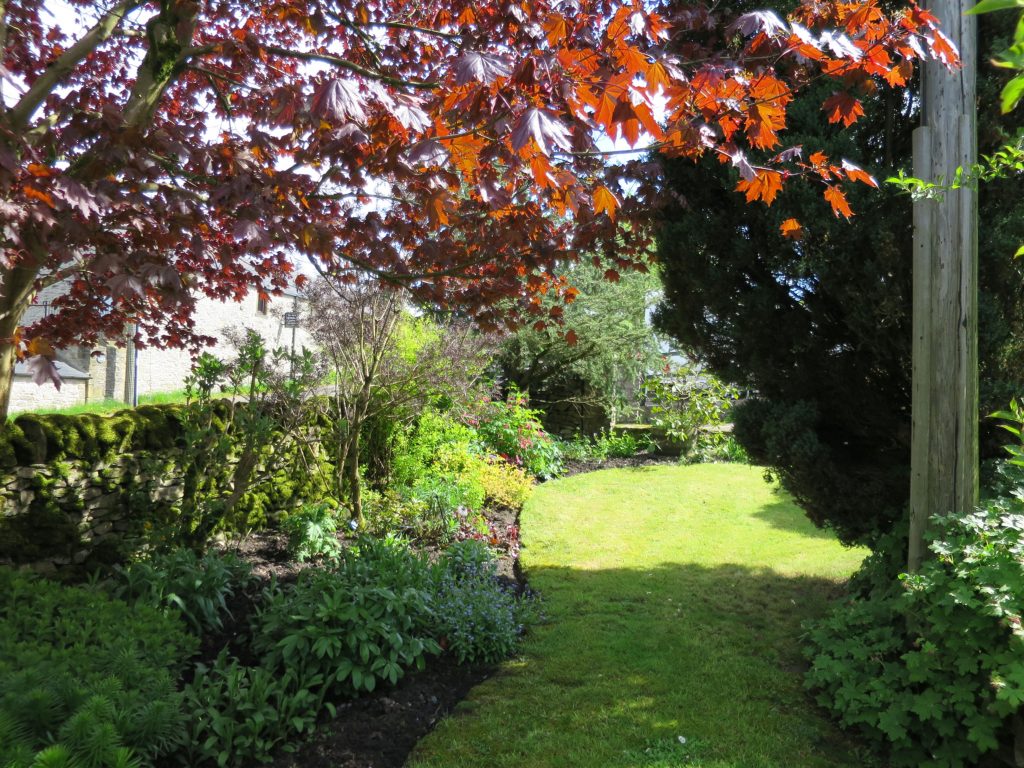
Extending the possibilities
Continued on Page 2
17 replies on “1. Early Days”
Hm,.. amazing post ,.. just keep the good work on!
Loving your blog and your content. Keep up the good work and please keep the content coming.
Hello there, You’ve done an incredible job. I抣l definitely digg it and personally recommend to my friends. I am confident they will be benefited from this web site.
I really like your writing style, wonderful information, thanks for putting up : D.
Je chérit cette photographie toutefois j’en ai avant cela vu de semblable de meilleures modalités
I wanted to say thank you to you for this excellent read!! I have you saved as a favorite to see fresh stuff you post.
Deference to author , some great selective information .
very good submit, i actually love this website, keep on it
I’m a little surprised at how interesting your content is. I think you should make an ebook out of this information. Thank you for sharing.
Spot up for this write-up, I truly believe this web site wants considerably more consideration. I’ll more likely be again to study considerably more, thank you for that information.
It’s a shame you don’t have a donate button! I’d certainly donate to this brilliant blog! I suppose for now i’ll settle for book-marking and adding your RSS feed to my Google account. I look forward to fresh updates and will share this site with my Facebook group. Chat soon!
I am really glad I’ve found this information. Nowadays bloggers publish only about gossips and web and this is really frustrating. A good blog with exciting content, this is what I need. Thank you for keeping this web-site, I’ll be visiting it. Do you do newsletters? Can’t find it.
Thanks on your marvelous posting! I actually enjoyed reading it, you could be a great author.
I will remember to bookmark your blog and will often come back very
soon. I want to encourage that you continue your great posts, have a nice holiday weekend!
Good blogs thanks
This blogpost answered a lot of questions I had. I’m bookmarking this for future reference. I appreciate the detailed information shared here. Your writing style makes this topic very engaging. Thank you for breaking down complex concepts so clearly. I’ve been searching for information like this for a while. This blog stands out among others in this niche. Thank you for breaking down complex concepts so clearly. Such a helpful article, thanks for posting!
Hi there would you mind stating which blog platform you’re working with?
I’m looking to start my own blog soon but I’m having a difficult time making a decision between BlogEngine/Wordpress/B2evolution and
Drupal. The reason I ask is because your design and style seems different then most blogs
and I’m looking for something completely unique.
P.S Apologies for getting off-topic but I had to ask!
I used WordPress